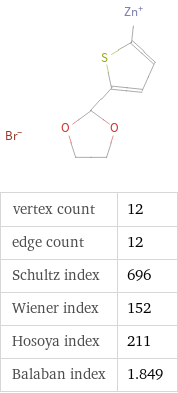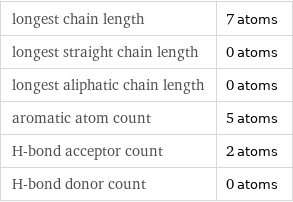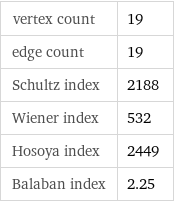Input interpretation

5-(1, 3-dioxolan-2-yl)-2-thienylzinc bromide
Basic properties
![molar mass | 300.5 g/mol formula | C_7H_7BrO_2SZn empirical formula | Br_O_2C_7S_Zn_H_7 SMILES identifier | C1=C(C2OCCO2)SC(=C1)[Zn+].[Br-] InChI identifier | InChI=1/C7H7O2S.BrH.Zn/c1-2-6(10-5-1)7-8-3-4-9-7;;/h1-2, 7H, 3-4H2;1H;/q;;+1/p-1/fC7H7O2S.Br.Zn/h;1h;/q;-1;m InChI key | WTDCLAGWBXSEGC-UHFFFAOYSA-M](../image_source/749e6c3ca0c2d5b1bf013f196e0b1e91.png)
molar mass | 300.5 g/mol formula | C_7H_7BrO_2SZn empirical formula | Br_O_2C_7S_Zn_H_7 SMILES identifier | C1=C(C2OCCO2)SC(=C1)[Zn+].[Br-] InChI identifier | InChI=1/C7H7O2S.BrH.Zn/c1-2-6(10-5-1)7-8-3-4-9-7;;/h1-2, 7H, 3-4H2;1H;/q;;+1/p-1/fC7H7O2S.Br.Zn/h;1h;/q;-1;m InChI key | WTDCLAGWBXSEGC-UHFFFAOYSA-M
Structure diagram

vertex count | 12 edge count | 12 Schultz index | 696 Wiener index | 152 Hosoya index | 211 Balaban index | 1.849
Quantitative molecular descriptors

longest chain length | 7 atoms longest straight chain length | 0 atoms longest aliphatic chain length | 0 atoms aromatic atom count | 5 atoms H-bond acceptor count | 2 atoms H-bond donor count | 0 atoms
Elemental composition

Find the elemental composition for 5-(1, 3-dioxolan-2-yl)-2-thienylzinc bromide in terms of the atom and mass percents: atom percent = N_i/N_atoms × 100% mass percent = (N_im_i)/m × 100% Plan: • Write the chemical formula and gather atomic masses from the periodic table. • Determine values for N_i, m_i, N_atoms and m using these items. • Finally, compute the percents and check the results. Write the chemical formula: C_7H_7BrO_2SZn Use the chemical formula, C_7H_7BrO_2SZn, to count the number of atoms, N_i, for each element and find the total number of atoms, N_atoms: | number of atoms Br (bromine) | 1 O (oxygen) | 2 C (carbon) | 7 S (sulfur) | 1 Zn (zinc) | 1 H (hydrogen) | 7 N_atoms = 1 + 2 + 7 + 1 + 1 + 7 = 19 Divide each N_i by N_atoms to calculate atom fractions. Then use the property that atom fractions must sum to one to check the work: | number of atoms | atom fraction Br (bromine) | 1 | 1/19 O (oxygen) | 2 | 2/19 C (carbon) | 7 | 7/19 S (sulfur) | 1 | 1/19 Zn (zinc) | 1 | 1/19 H (hydrogen) | 7 | 7/19 Check: 1/19 + 2/19 + 7/19 + 1/19 + 1/19 + 7/19 = 1 Compute atom percents using the atom fractions: | number of atoms | atom percent Br (bromine) | 1 | 1/19 × 100% = 5.26% O (oxygen) | 2 | 2/19 × 100% = 10.5% C (carbon) | 7 | 7/19 × 100% = 36.8% S (sulfur) | 1 | 1/19 × 100% = 5.26% Zn (zinc) | 1 | 1/19 × 100% = 5.26% H (hydrogen) | 7 | 7/19 × 100% = 36.8% Look up the atomic mass, m_i, in unified atomic mass units, u, for each element in the periodic table: | number of atoms | atom percent | atomic mass/u Br (bromine) | 1 | 5.26% | 79.904 O (oxygen) | 2 | 10.5% | 15.999 C (carbon) | 7 | 36.8% | 12.011 S (sulfur) | 1 | 5.26% | 32.06 Zn (zinc) | 1 | 5.26% | 65.38 H (hydrogen) | 7 | 36.8% | 1.008 Multiply N_i by m_i to compute the mass for each element. Then sum those values to compute the molecular mass, m: | number of atoms | atom percent | atomic mass/u | mass/u Br (bromine) | 1 | 5.26% | 79.904 | 1 × 79.904 = 79.904 O (oxygen) | 2 | 10.5% | 15.999 | 2 × 15.999 = 31.998 C (carbon) | 7 | 36.8% | 12.011 | 7 × 12.011 = 84.077 S (sulfur) | 1 | 5.26% | 32.06 | 1 × 32.06 = 32.06 Zn (zinc) | 1 | 5.26% | 65.38 | 1 × 65.38 = 65.38 H (hydrogen) | 7 | 36.8% | 1.008 | 7 × 1.008 = 7.056 m = 79.904 u + 31.998 u + 84.077 u + 32.06 u + 65.38 u + 7.056 u = 300.475 u Divide the mass for each element by m to calculate mass fractions. Then use the property that mass fractions must sum to one to check the work: | number of atoms | atom percent | mass fraction Br (bromine) | 1 | 5.26% | 79.904/300.475 O (oxygen) | 2 | 10.5% | 31.998/300.475 C (carbon) | 7 | 36.8% | 84.077/300.475 S (sulfur) | 1 | 5.26% | 32.06/300.475 Zn (zinc) | 1 | 5.26% | 65.38/300.475 H (hydrogen) | 7 | 36.8% | 7.056/300.475 Check: 79.904/300.475 + 31.998/300.475 + 84.077/300.475 + 32.06/300.475 + 65.38/300.475 + 7.056/300.475 = 1 Compute mass percents using the mass fractions: Answer: | | | number of atoms | atom percent | mass percent Br (bromine) | 1 | 5.26% | 79.904/300.475 × 100% = 26.59% O (oxygen) | 2 | 10.5% | 31.998/300.475 × 100% = 10.65% C (carbon) | 7 | 36.8% | 84.077/300.475 × 100% = 27.98% S (sulfur) | 1 | 5.26% | 32.06/300.475 × 100% = 10.67% Zn (zinc) | 1 | 5.26% | 65.38/300.475 × 100% = 21.76% H (hydrogen) | 7 | 36.8% | 7.056/300.475 × 100% = 2.348%
Elemental oxidation states

The first step in finding the oxidation states (or oxidation numbers) in 5-(1, 3-dioxolan-2-yl)-2-thienylzinc bromide is to draw the structure diagram. Next set every oxidation number equal to the atom's formal charge: In 5-(1, 3-dioxolan-2-yl)-2-thienylzinc bromide hydrogen is not bonded to a metal with lower electronegativity, so it will have an oxidation state of +1. Any element bonded to hydrogen gains the bonding electrons, decreasing their oxidation state by 1 for every bond: With hydrogen out of the way, look at the remaining bonds. There are 4 carbon-oxygen bonds, 2 carbon-sulfur bonds, 1 carbon-zinc bond, and 5 carbon-carbon bonds. For each of these bonds, assign the bonding electrons to the most electronegative element. First examine the carbon-oxygen bonds: element | electronegativity (Pauling scale) | C | 2.55 | O | 3.44 | | | Since oxygen is more electronegative than carbon, the electrons in these bonds will go to oxygen. Decrease the oxidation number for oxygen in every highlighted bond (by 1 for single bonds, 2 for double bonds, and 3 for triple bonds), and increase the oxidation number for carbon accordingly: Next look at the carbon-sulfur bonds: element | electronegativity (Pauling scale) | C | 2.55 | S | 2.58 | | | Since sulfur is more electronegative than carbon, the electrons in these bonds will go to sulfur: Next look at the carbon-zinc bond: element | electronegativity (Pauling scale) | C | 2.55 | Zn | 1.65 | | | Since carbon is more electronegative than zinc, the electrons in this bond will go to carbon: Next look at the carbon-carbon bonds: element | electronegativity (Pauling scale) | C | 2.55 | C | 2.55 | | | Since these elements are the same the bonding electrons are shared equally, and there is no change to the oxidation states: Now summarize the results: Answer: | | oxidation state | element | count -2 | O (oxygen) | 2 | S (sulfur) | 1 -1 | Br (bromine) | 1 | C (carbon) | 4 0 | C (carbon) | 1 +1 | C (carbon) | 2 | H (hydrogen) | 7 +2 | Zn (zinc) | 1
Topological indices

vertex count | 19 edge count | 19 Schultz index | 2188 Wiener index | 532 Hosoya index | 2449 Balaban index | 2.25